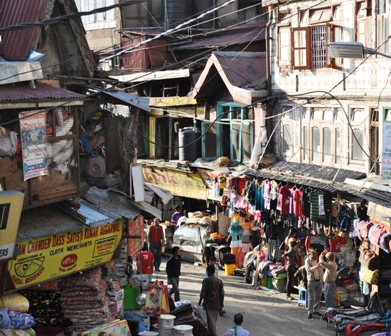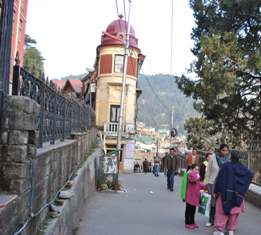One of my blog friend Scott Hass visited Shimla last year and lived in the tranquil and peaceful neighborhood of Mashobra. When I went visiting him to Mashobra and asked him about the places that he loved in Shimla, I was pleasantly surprised to hear him say, “I loved Lower Bazaar!”
“And didn’t you like the Mall?” I asked him with a real surprise in my voice.
“The Mall is just Okay, it is like any other place but it is the Lower Bazaar that holds the spirit of real Shimla!” he said with an emphasis.
This was nothing less than a revelation to me as I had seen countless tourists roaming on the famous Ridge admiring the timeless beauty of the Chirst church, strolling languishly on the Mall, and reclining on the fashionable benches to rest a while instead of rubbing their shoulders with the ordinary people of Shimla in the crowded Lower Bazaar.
Though the Lower Bazaar Shimla to me, a person born in a narrow alley of lower Bazaar, held a special charm but such a remark coming from an American tourist and that too a writer of repute was nothing less than a great surprise to me.

Yes, he was so right. The Lower Bazaar is the essence and the life of Shimla. With a sense of remorse do I think that why don’t we write about the Lower Bazaar as we write about the Mall?
I thought of the pictures of the Mall that I have stored in my camera but when it comes to the Lower Bazaar, only a few are there.
And this led me to think about how I feel about the great divide which separated the Mall from the Lower Bazaar. This divide is not a figurative physical divide but a great mental divide as well.
Whether you walk from the eastern side of Shimla i.e. from Chhota Shimla or from the western end of the town i.e. Chaura Maidan side, one common similarity is seen at the point where the road bifurcates.
The upper road proudly leads to the Mall and the Ridge but the lower road shyly meanders to the Lower Bazaar.
From the Western end it is at CTO that the road to Lower Bazaar starts. This long road is connected to the Mall through a number of stairs which frighten persons with a weak hearts and weaker limbs.
The buildings situated on the Mall, towards the Lower Bazaar, are unique in a manner that the one half of these buildings faces the Mall and the other half descends down towards the Lower Bazaar.
In between a portion of the building touches what is known as the Middle Bazaar. This segmentation in higher, middle and lower categories of the building is what reflects in the life of the people living in these very areas.
As a young girl born in Lower Bazaar Simla, I have experienced my early years of girlhood in Lower Bazaar and this divide was more pronounced for us as many of my friends lived on the Mall!
The Mall always remained the other world– formal, refined and elite whereas the world of Lower Bazaar was homely and informal.
And now when I am thinking of my life, I am reminded of many symbols that stood for life in the Lower bazaar, the symbols that meant nothing at that point in time.
If the Mall and the Ridge had Takka benches and the famous green benches made of solid wood, the Lower Bazaar, a poor cousin to the Mall had solid almost square cement blocks of the height of three feet whereupon the cooleys could rest their backs by balancing the heavy load on those blocks.
I had watched many cooleys resting a while and catching a breath while sweat drops would trickle down their forehead.
Perhaps as I had grown up watching these scenes every day of my childhood they had become very common for me and I never ever found anything absurd in these.
In the same manner I would not blink my eye when I would see people reclining on benches that abound the Mall. It was a well earned rest for the strollers when they get tired of roaming on the Mall.
Thinking of all these scenes that are still fresh in my mind today after a gap of some forty years, I am able to see with a sense of detachment that how human mind learns to take for granted something which is never questioned.
For me the labourers carrying heavy loads, the pahari natives carrying fuel wood, the Khans carrying big loads of coal on their backs, was as normal as were the strollers on the Mall, men with a walking stick in hand and coquettish women pretending to be so tired of walking and catching their breath on the famous benches of the Mall, perhaps trying to catch the attention of the onlookers!
Intrigued by the great divide theory I asked one of the old timer of Shimla who is at present in her late eighties, “Did you ever see Mem Sahibs coming to the Lower Bazaar?”
Since my acquaintance, a dear aunty, lives at a strategic point in the Lower Bazaar and has grown up watching the present Shimla emerging from the Simla of the Raj, her memories are worth mentioning.
“Yes, they would come sometimes to the book market.” I was surprised to learn about the book market.
Watching out from the window she looked at the Arya Samaj Mandir down and said, “a number of book shops existed from Arya Samaj Mandir to Dr Jagat Ram’s shop and some teachers from the convent of Tara Hall would come sometimes to these shops.”
The present day Shimla still carries the legacy of the Raj days and the present day Sahibs and Mem Sahibs emulate ways of the yore and it is not very often that we find the fashionable crowd of the Mall mingling with the majority of ordinary men and women of the Lower Bazaar.
And Shimla, even today, has maintained the great divide introduced since the days of Raj and even today we have two different worlds silently co-existing complementing each other.
Photos by Saroj Thakur
Saroj Thakur is a writer, blogger and teacher.
Born (1956) in Shimla, Saroj was previously a fellow at IIAS Shimla (2009-2010). She writes on women, gender, mythology, and language studies. She has been teaching at National Institute of Technology (N.I.T. Hamirpur) since last 26 years.
An active blogger, trekker and an RTI enthusiast Saroj Thakur presently lives in Hamirpur town of the Indian state of Himachal Pradesh.
Follow on : http://sarojthakur.wordpress.com/




Mesmerizing description of the Elites and commons.
Nice article 🙂
A VERY NICE DESCRIPTION INDEED
Its a proclaimed truth and fallacy has to be removed out from the minds of people bout the better half of shimla (lower bazar) ! voluptuous article ! loved it !